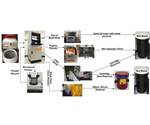Video: Topology Optimization in Action
What is topology optimization, and how does it work? See the process for lightweighting a legacy part step-by-step using this design strategy in the video in this blog post.

These 3D printed ABS models show the comparison between a torque arm designed for machining (bottom) and that same component redesigned for additive manufacturing with the use of topology optimization (top). See the full process in the video below.
Topology optimization (sometimes abbreviated TO) is a software-driven design strategy that uses algorithms to determine the optimal form for a given part. The software uses input from the user — connectors/faces to preserve, material and application requirements — to remove as much material as possible from a solid model while preserving its functionality. (A related strategy, generative design, instead focuses on growing the part from the ground up, and applying material only where it is needed.) Topology optimized geometries are often organic-looking and tend to be lighter weight than those designed by hand. And while the strategy can be applied to part designs intended for casting or machining, it is a natural complement to additive manufacturing (AM), where complexity is more easily achieved.
The topology optimization of a part is only one step in the design process, however. The solved optimization is typically too complex to be manufactured as-is, and must be refined for manufacturability. The benefit of beginning with topology optimization, though, is that the designer can use the optimization to understand which features and characteristics are truly necessary for the part to perform its intended function. The optimization becomes the inspiration and basis for the final design.
What does this look like in practice? I recently had the chance to talk with Matt Humrick, engineering manager at Advatech Pacific, and Pam Waterman, 3D printing applications engineer for Phoenix Analysis & Design Technologies (PADT), about topology optimizing a legacy component for a gas turbine engine. The original part is a torque arm machined from 17-4 stainless steel; the new design is intended to be 3D printed in the same material via powder bed fusion, and weighs 45% less. See the video below for a step-by-step walk-through using the ANSYS platform (more detail also available in this article).
Related Content
-
Digital Thread Enables First-Time-Right 3D Printing
Connecting all stages of manufacturing, from design to postprocessing, helps break down barriers to industrializing additive manufacturing.
-
An Additive Manufacturing Machine Shop
Finish machining additively manufactured implants requires different pacing and workflow than cutting parts from stock — different enough for an experienced manufacturer to warrant a dedicated machine shop.
-
In Moldmaking, Mantle Process Addresses Lead Time and Talent Pool
A new process delivered through what looks like a standard machining center promises to streamline machining of injection mold cores and cavities and even answer the declining availability of toolmakers.

.jpg;width=70;height=70;mode=crop)










.png;maxWidth=300;quality=90)
